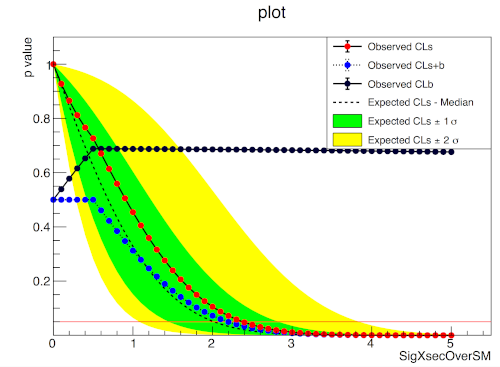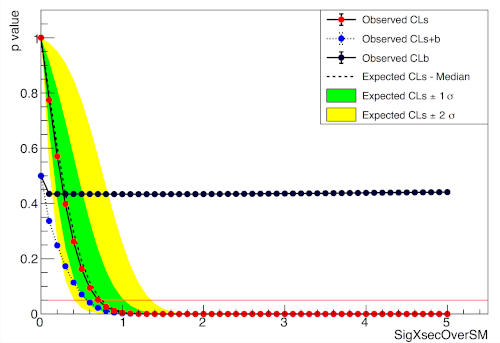The HistFactory p.d.f. template [CERN-OPEN-2012-016] is per-se independent of its implementation in ROOT and sometimes, it’s useful to be able to run statistical analysis outside of ROOT, RooFit, RooStats framework.
This repo is a pure-python implementation of that statistical model for multi-bin histogram-based analysis and its interval estimation is based on the asymptotic formulas of “Asymptotic formulae for likelihood-based tests of new physics” [arXiv:1007.1727]. The aim is also to support modern computational graph libraries such as PyTorch and TensorFlow in order to make use of features such as autodifferentiation and GPU acceleration.
>>> import pyhf
>>> pdf = pyhf.simplemodels.hepdata_like(signal_data=[12.0, 11.0], bkg_data=[50.0, 52.0], bkg_uncerts=[3.0, 7.0])
>>> CLs_obs, CLs_exp = pyhf.infer.hypotest(1.0, [51, 48] + pdf.config.auxdata, pdf, return_expected=True)
>>> print('Observed: {}, Expected: {}'.format(CLs_obs, CLs_exp))
Observed: [0.05290116], Expected: [0.06445521]- Implemented variations:
- ☑ HistoSys
- ☑ OverallSys
- ☑ ShapeSys
- ☑ NormFactor
- ☑ Multiple Channels
- ☑ Import from XML + ROOT via uproot
- ☑ ShapeFactor
- ☑ StatError
- ☑ Lumi Uncertainty
- Computational Backends:
- ☑ NumPy
- ☑ PyTorch
- ☑ TensorFlow
- ☑ JAX
Available Optimizers
| NumPy | Tensorflow | PyTorch |
|---|---|---|
SLSQP
(scipy.optimize
) |
Newton’s Method (autodiff) | Newton’s Method (autodiff) |
MINUIT
(iminuit) |
. | . |
- ☐ StatConfig
- ☐ Non-asymptotic calculators
results obtained from this package are validated against output computed from HistFactory workspaces
nobs = 55, b = 50, db = 7, nom_sig = 10.bin 1: nobs = 100, b = 100, db = 15., nom_sig = 30.
bin 2: nobs = 145, b = 150, db = 20., nom_sig = 45.To install pyhf from PyPI with the NumPy backend run
python -m pip install pyhfand to install pyhf with all additional backends run
python -m pip install pyhf[backends]or a subset of the options.
To uninstall run
python -m pip uninstall pyhfIf you have a question about the use of pyhf not covered in the
documentation, please ask a question
on Stack Overflow
with the [pyhf] tag, which the pyhf dev team
watches.

If you believe you have found a bug in pyhf, please report it in the
GitHub
Issues.
As noted in Use and
Citations, the preferred
BibTeX entry for citation of pyhf is
@software{pyhf,
author = "{Heinrich, Lukas and Feickert, Matthew and Stark, Giordon}",
title = "{pyhf: v0.4.3}",
version = {0.4.3},
doi = {10.5281/zenodo.1169739},
url = {https://github.com/scikit-hep/pyhf},
}pyhf is openly developed by Lukas Heinrich, Matthew Feickert, and Giordon Stark.
Please check the contribution statistics for a list of contributors.
Matthew Feickert has received support to work on pyhf provided by NSF
cooperative agreement OAC-1836650 (IRIS-HEP)
and grant OAC-1450377 (DIANA/HEP).













